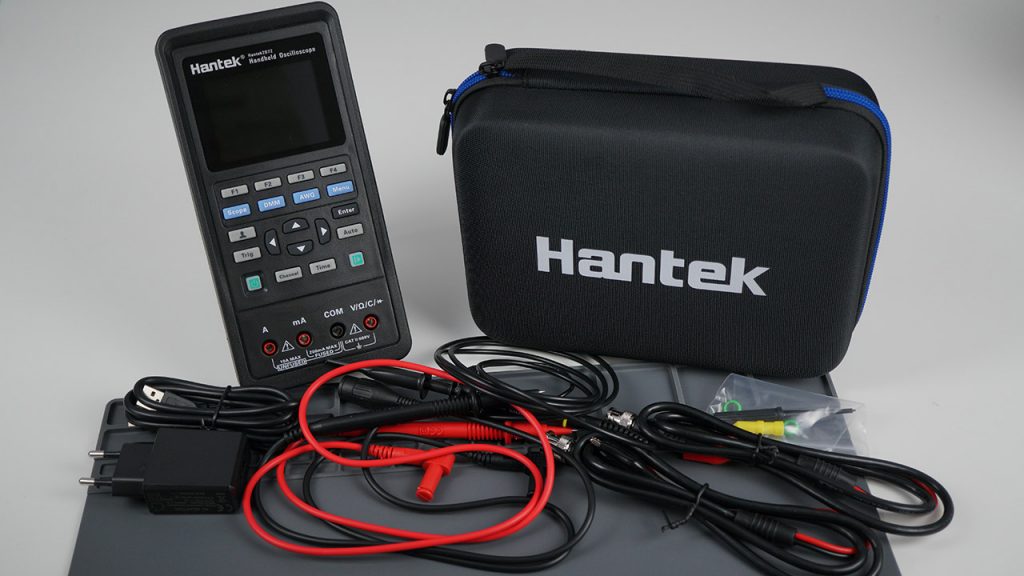
The Hantek 2D72 is a 3 in 1 measurement tool that combines an oscilloscope, a digital multimeter, and a signal generator.
This tool has been in our radar for a while. We finally got it and we’ll review it in this article. Here’s a quick overview:
- Dual Channel Oscilloscope: bandwidth of 70MHz or 40MHz;
- Digital Multimeter: 4000 counts, voltage, current, resistance, diode, capacitors, continuity test;
- Waveform generator: sine, square, triangle, trapezoidal, and other waveforms up to 25MHz.
This tool is powered using rechargeable batteries, and it doesn’t occupy much space, so it is handy for work in the field. Additionally, it can also be a great addition to your electronics lab because you can have all those functions (multimeter, oscilloscope, and function generator) on a single tool.
Watch the Video Review
You can watch the Hantek 3 in 1 2D72 video review, or you can scroll down to continue reading.
You might also like reading: Best Workbench Oscilloscopes for Beginners
Where to Buy?
The Hantek 3 in 1 measurement tool is available on Banggood for less than $200.
Banggood - Hantek 3in1 Digital Oscilloscope+Waveform Generator+Multimeter (2D72) 70MHz
$167.99 out of stock
You can also get it on the following stores.
In this article, we’re going to review the 2D72 model. There are other versions with other specs. Here’s a quick table comparing the different versions.
| Model | Bandwidth | Channel | Sample Rate |
| Hantek 2D72 | 70MHz | 2CH + DMM + AWG | 250Msa/s (single channel), 125MSa/s (dual channel) |
| Hantek 2D42 | 40MHz | 2CH + DMM + AWG | 250Msa/s (single channel), 125MSa/s (dual channel) |
| Hantek 2C72 | 70MHz | 2CH + DMM | 250Msa/s (single channel), 125MSa/s (dual channel) |
| Hantek 2C42 | 40MHz | 2CH + DMM | 250Msa/s (single channel), 125MSa/s (dual channel) |
Label: CH (oscilloscope channels), DMM (digital multimeter), AWG (waveform generator).
The Hantek 2C42 is the most affordable version (40MHz bandwidth and it doesn’t include waveform generator).
Product Details and Specifications
The Hantek 2D72 combines an oscilloscope, a digital multimeter, and a signal generator in a single measurement tool. Here are the most relevant specs and details of the multimeter, oscilloscope, and waveform generator. For a more in-depth list, visit the product page.
Oscilloscope
- Dual channel
- Sampling rate: 250Msa/s (single channel), 125Msa/s (dual channel)
- Bandwidth: 70MHz
- Vertical resolution: 10mV to 10V
- Horizontal resolution: 50ns/div
- Automatic measurement functions
- Storage function
- Cursor measurement
Digital Multimeter
- 4000 counts
- AC/DC voltage and current measurement
- Resistance
- Diode testing
- Capacitance
- Continuity test
Waveform Generator
- Sampling rate: 250MSa/s
- Vertical resolution: 12-bits
- Sine: 1Hz to 25MHz
- Square: 1Hz to 10MHz
- Triangular: 1Hz to 1MHz
- Trapezoid: 1Hz to 5MHz
- Output impedance: 50 Ohm
Hantek 3 in 1 Unboxing

The measurement tool and all the accessories came inside an impact-resistant and portable hard case. The case seems really high quality, and it’s handy to carry or keep everything neatly organized.
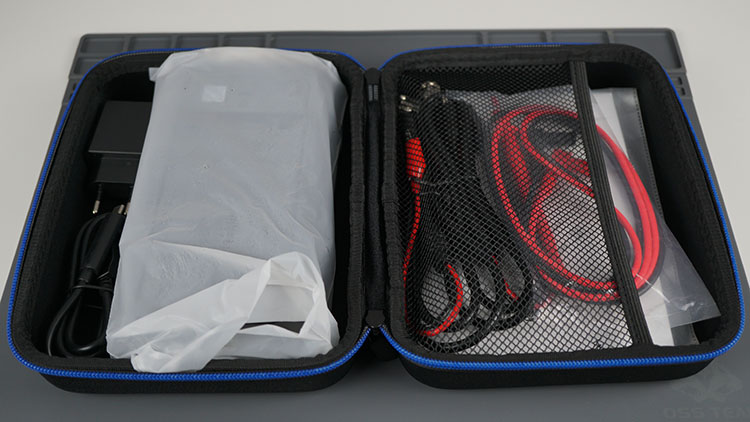
The package includes:
- 1x Hantek 2D72 3 in 1 measurement tool
- 1x oscilloscope probes
- 2x function generator probes
- Mini screwdriver to adjust oscilloscope probe attenuation
- 1x power adapter (you receive the proper adapter for your country)
- Manual with specifications
- Portable case

Hantek 3 in 1 Overview
Now let’s take a closer look at the Hantek 2D72 features. As mentioned previously, it came inside a high-quality case which is nice for storage or transport.
The measurement tool itself is protected with a silicone cover to make it more resistant to impact. It is sturdy, the buttons are soft with a nice touch feeling and it’s a bit heavy (624g).
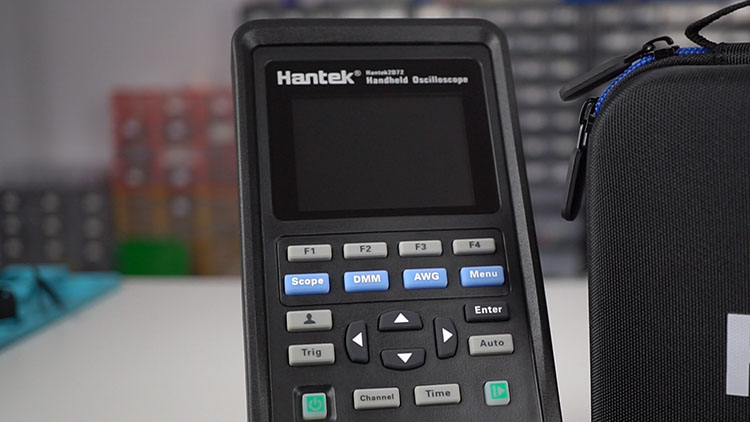
Rechargeable 18650 Lithium Batteries
It is powered by 18650 rechargeable lithium batteries that are widely available. So if you need replacements, you’ll find them easily.

It charges via a USB-C interface using the power adapter or connected directly to a USB port on your computer. It can be in charge and operate simultaneously, which is a nice feature.
Accordingly to the product page, charging the batteries takes about 2 hours, and the batteries can last a full day in continuous operation or more than two months in standby mode (we haven’t tested this yet).
Tilt Stand
At the back, there is a tilt stand. It’s a bit stiff, but after using it several times it hasn’t broken yet.
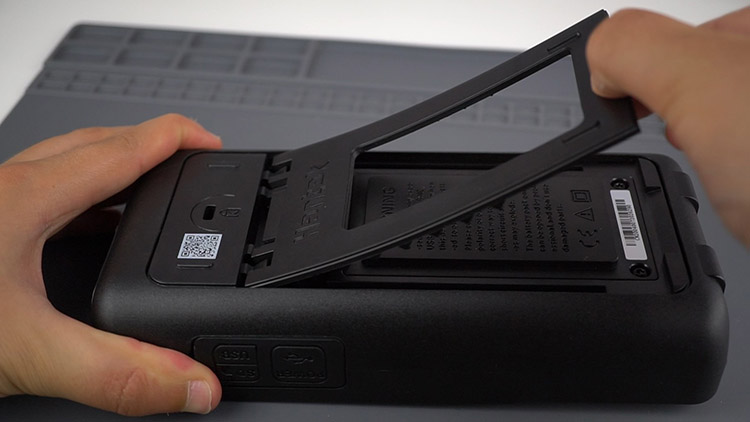
LCD Screen
The screen is a 2.8 inch full-color TFT display. It is large enough to see all the measurements and the colors make it easier to read and visualize the waveforms. The screen backlight can be adjusted for better contrast.
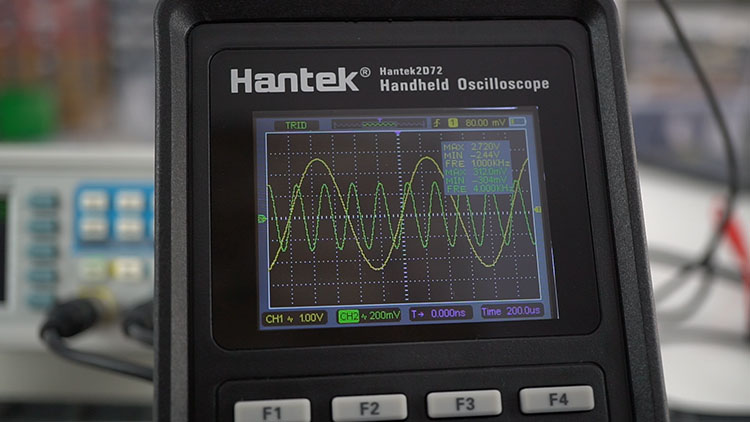
Inputs and Outputs

The Hantek 72D2 features the following inputs/outputs:
- Input for multimeter cables
- Inputs for two oscilloscope channels
- Output for function generator
- Port to charge the battery
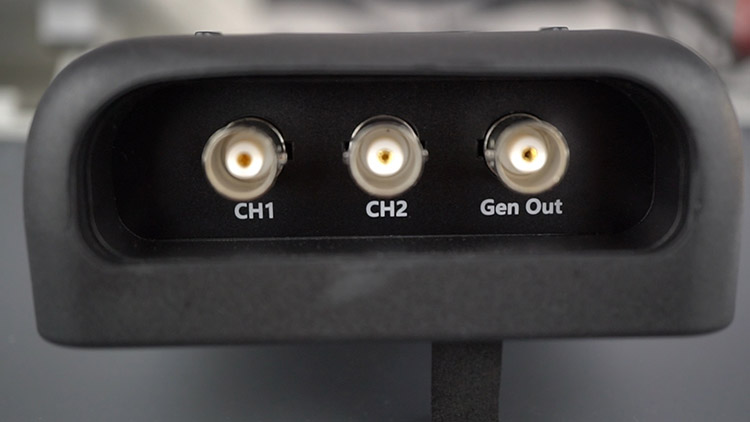
Hantek 3 in 1 Operation

One of the drawbacks of the Hantek 2D72 is that it comes with few buttons to control so many functions. But you’ll get used to it in no time, and it is very intuitive to use.
The blue keys change between the oscilloscope (Scope) digital multimeter (DMM) and function generator (AWG).
The F1, F2, F3 and F4 keys are used to select the menus on each screen.
The Trig, Auto, Channel and Time keys are used to show the oscilloscope trigger menu, auto set function, select and enable channels and time menu, receptively.
The run/stop key is used to start and stop the function generator. It can also be used with the multimeter to hold a measurement.
Oscilloscope Operation

To use the oscilloscope, insert the scope probes on the BNC connect and press the Scope blue key to go select the oscilloscope screen. Once there, you can use the F or the Menu keys to show the oscilloscope menu.
You can select and enable vertical and horizontal cursors to take measurements. Positioning the cursors on the waveform is not as practical as using knobs in a full-featured oscilloscope. With this tool, you need to use the arrow keys to move the cursors. It shows the position of each cursor and the range between them. This is useful for measuring waveform properties.
Additionally, there’s a Measure function that automatically shows the frequency and the amplitude (minimum and maximum) for both channels.
Still, on the oscilloscope screen, you can press the Channel, Time and Trigger keys to set the channel properties, time properties and select the trigger options.
This oscilloscope doesn’t replace a full-feature oscilloscope, but I found it very useful and easy to use. It contains the main functions you’ll need in most of your hobbyists’ electronics projects and other applications.
Additionally, it doesn’t occupy much space and it also includes multimeter and function generator functions. This is great for your electronics lab.
Multimeter Operation
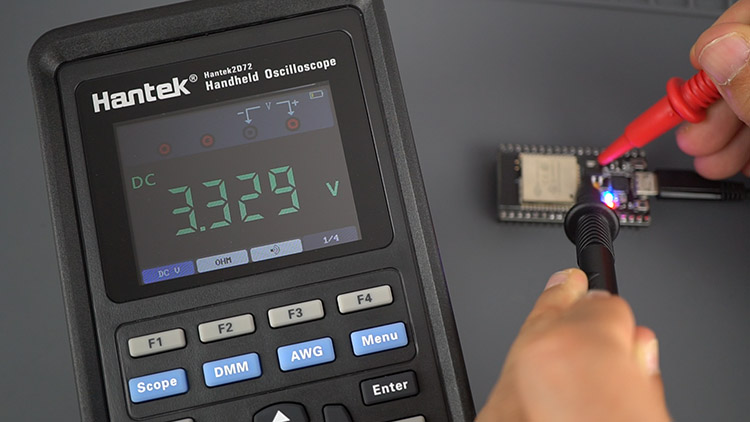
To use the multimeter, connect the black probe on the COM port and the red probe on one of the other ports depending on what you want to measure. Press the DMM blue key to go to the multimeter screen.
Once on the multimeter screen, you can use the F keys to select what you want to measure. You can measure AC and DC voltage and current, resistance, capacitance, diode testing, and continuity.
Then, just place the probes appropriately to take your measurements. It is as easy as using a regular multimeter.
Waveform Generator
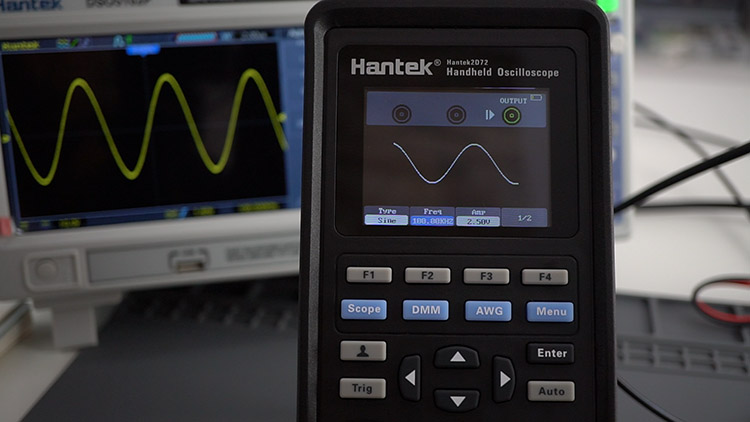
To use the waveform generator, place the appropriate cable on the output labeled “Gen Out” and press the AWG blue key.
Then, use the F keys to set the waveform you want to generate and its properties. You can select square, triangular, sine, trapezoid, several arbitrary waveforms, and so on.
You can set the frequency and amplitude using the arrow keys or set values by double pressing the corresponding F key.
Wrapping Up
So, let’s wrap up this review up with some pros and cons.
Starting with the pros:
- Durable materials and high quality build;
- Having a multimeter, oscilloscope and function generator on the same tool is great;
- It’s easy and intuitive to use;
- It doesn’t occupy much space, so if you need to perform some work on the field or if you have a small workplace, this is just great;
- It uses rechargeable batteries that are widely available;
- It can be in operation while charging;
- It’s portable;
- The screen is wide and the colors make it easy to visualize the readings and waveforms.
Onto some of the cons:
- We didn’t like the tilt stand, which is very stiff.
- It has very few buttons for so many functions, which can be confusing at first.
Nonetheless, we don’t think these are real deal breakers and we really recommend this tool.
Additionally, if you can’t afford a full feature oscilloscope, this can be a great option and even comes with the multimeter and waveform generator functions.
Note that this doesn’t replace a full-feature oscilloscope (read Best Oscilloscopes for Beginners). However, if you don’t need to do anything too fancy with the oscilloscope, I absolutely recommend the Hantek 2D72 3 in 1 measurement tool.
We hope you’ve found this review useful. Thanks for reading and don’t forget to subscribe our newsletter.
[Recommended Course] Learn ESP32 with Arduino IDE
Register in our brand new ESP32 course with Arduino IDE. This is our complete guide to program the ESP32 with Arduino IDE, including projects, tips, and tricks! The registrations are open, so sign up now.
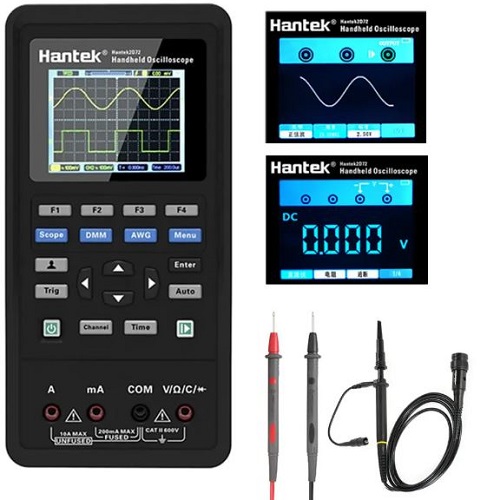





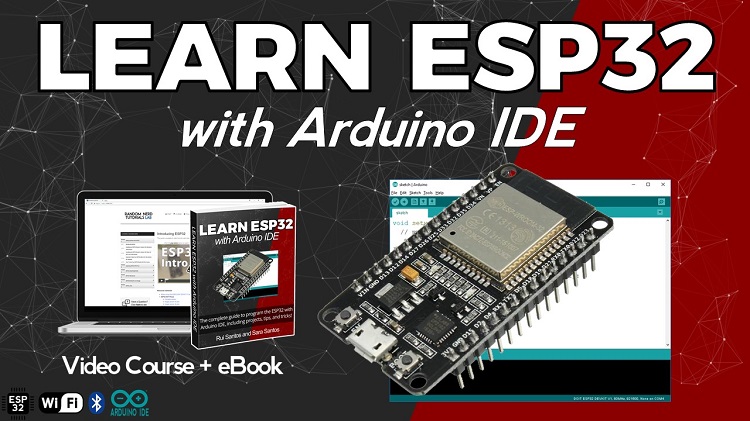
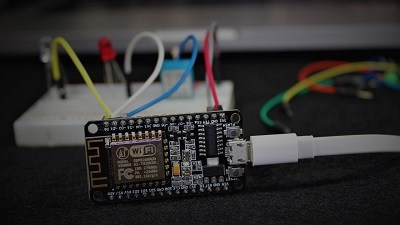 [eBook] Home Automation using ESP8266 »
[eBook] Home Automation using ESP8266 » [Course] Build a Home Automation System »
[Course] Build a Home Automation System » [Course] Arduino Step-by-Step Projects »
[Course] Arduino Step-by-Step Projects »
Leave a Reply